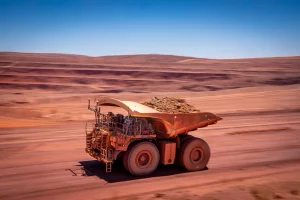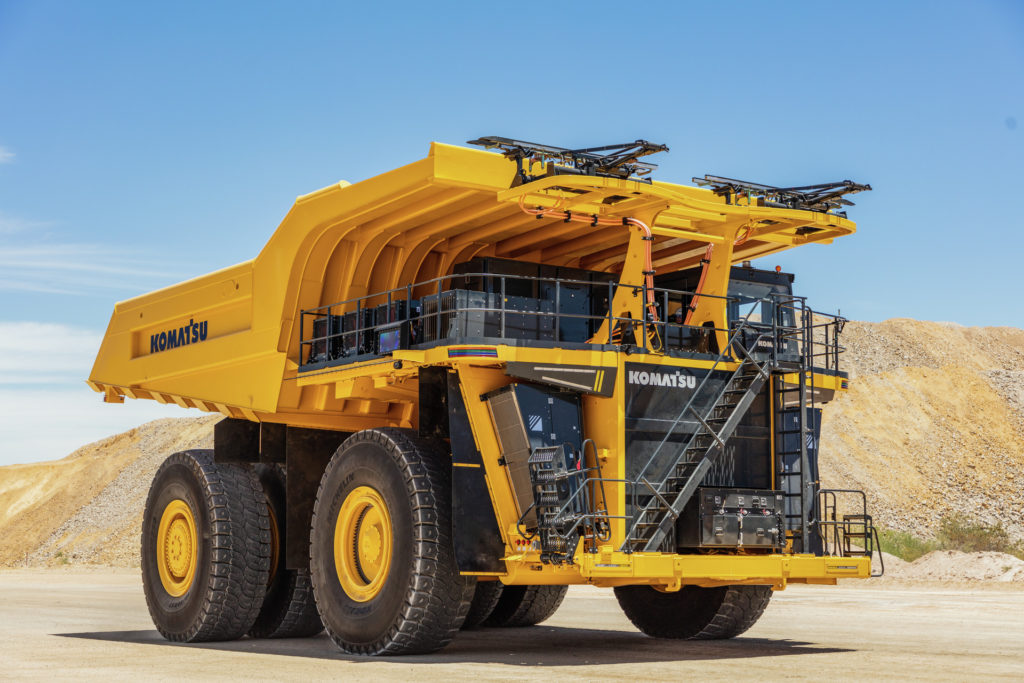An in-depth update was given by BHP on October 3 on its Western Australia Iron Ore (WAIO) operations as part of a Site Tour – which included current progress and future roadmap for its haulage fleets on both autonomy and transition to battery electric.
But first BHP WAIO Asset President Brandon Craig walked through the big picture of WAIO’s strengths as an asset: “WAIO is favoured with an amazing endowment. This includes 30 billion tonnes of iron ore resource, of which approximately 95% is concentrated within 50 kilometres of existing infrastructure. To give an indication of scale, one of our larger competitors has around 10-12 hubs for 320 to 350 million tonnes per annum. We have four processing hubs which today support a production level of approximately 290 million tonnes per annum, and we have announced our plans to progress to 300 million tonnes per annum. Our South Flank and Mining Area C operations will soon be one of the world’s largest and most productive hubs at 145 million tonnes per annum alone. This structural setting enables simpler, more standardised operations, a lower mine replacement cycle, industry leading sustaining capital efficiency and unit cost benefits. At production levels exceeding 300 million tonnes per annum, an increase in sustaining mine development is required. We are continuing studies into mine expansion through crusher and conveyor infrastructure, including the possibility of wet processing infrastructure likely to be required at Newman to manage the increasing below water table ore. Studies are also under way as to what an increase to 330 million tonnes looks like, and we have a number of attractive options in the Central Pilbara.”
But he emphasised that WAIO’s success is founded both on its people and culture, with safety at the forefront. “Our people are critical to our success and we have a large-scale workforce of around 8,000 full time employees and more than 1,000 contractors. The culture and capability within our teams is our strength, and together with our structured operating system, reliable assets and extensive infrastructure, we are able to deliver outstanding results.” He adds: “How we bring our people and culture together with our systems, processes and technology, is setting us apart – unlocking potential and growing value.“
He had this to say on its latest autonomy advances: “At BHP, nothing is more important than safety, and that’s certainly the case across our WAIO operations. We’ve recently achieved 11 years without a fatality – the result of significant effort and focus over many years. Our lagging and leading safety indicators are also trending in the right direction, with some big improvements in the past five years. The continued roll–out of technology and automation across our business is also having a positive impact on our safety, including the Surface Mobile Equipment anti–collision program. We know from the safety performance at Jimblebar, autonomous trucks have resulted in 75% fewer collision incidents than at our non–autonomous mines. We are accelerating autonomy deployment across our operations. All our production drills across our 4 hubs are already fully autonomous, and in line with our fleet replacement strategy, ore haulage will be approximately 85% autonomous within the next 4 years with Yandi the only exception as the site nears end of life. These exciting next steps in our autonomous journey are expected to deliver further and significant safety, production and cost improvements as well as new job and development opportunities for people.”
At Newman Operations and South Flank, BHP has accelerated its autonomous haulage deployments, and Craig said this is creating more efficient, more productive and safer operations. “We are also leveraging the Integrated Remote Operations Centre (known as IROC) to optimise our supply chain. The centre was introduced over 10 years ago to monitor and direct operations across the entire supply chain, with all operators working in concert from the same control room in Perth 24/7, to solve problems faster and improve throughput.”
He adds: “Across WAIO, we have more than 1,000 units of equipment including 220 [large] haul trucks…since FY19, we have safely increased truck payload by 9% by introducing lightweight trays across our fleet, allowing trucks to carry additional tonnes per cycle. With a strong focus on improved equipment maintenance strategies developed by our Maintenance and Engineering Centre of Excellence – and more efficient ways of working, over the past three years we have increased annualised truck hours by 6% to approximately 6,200 hours…we are also making good progress on automation, with ~190 trucks expected to be autonomous in the medium term. Our autonomous fleet is achieving availability of 89% and haulage costs 20% below the WAIO average. Of course, as our mine footprint expands our haul cycles increase, but our productivity improvements are more than offsetting the impact of this.”

Craig then talked about technology as a key productivity enabler, improving safety, equipment reliability and increasing productivity across the value chain. This includes autonomous drills and trucks: “The introduction and expanding use of technology and innovation across WAIO is a key lever for us to unlock the productivity potential within the system. In 2016, we started our remotely operated blast hole drilling program at Yandi – managed from the IROC. Today, we now have one of the biggest autonomous drilling fleets in the world, with 26 rigs across our five operational sites. Our autonomous haulage journey has delivered safer, more reliable, and productive operations, starting at Jimblebar in 2017 and expanding to Newman East in 2020. At South Flank, our autonomous fleet is growing with 10 trucks currently operating autonomously. In the year ahead, we’ll convert the remainder of the South Flank haul truck fleet. Our Newman East operation is already fully autonomous. Studies are in progress to deploy automated trucks at Mining Area C and Newman West as we move towards having approximately 85% of the fleet automated by the end of FY27, capitalising on the significant benefits of improved safety and productivity outcomes.”
Dealing with decarbonisation – operational emissions
Then it was the turn of Anna Wiley – Vice President Planning and Technical at BHP Minerals Australia, discussing WAIO decarbonisation and specifically operational emissions. In 2020, BHP set a medium-term target to reduce Group operational emissions by at least 30% from FY2020 levels by FY2030, and it also set a long-term goal to achieve net zero operational emissions by 2050. “Our plan represents a balance between rapid implementation of renewable energy and advancement of diesel displacement in a way that preserves optionality and sets us up to achieve net zero emissions by 2050. It’s aspirational, but achievable.”
Wiley continued: “Overall WAIO accounts for around a quarter of BHP’s total greenhouse gas emissions but the source of these emissions differs from the rest of BHP Group as a whole…in FY20 roughly 40% of BHP’s total Group emissions came from electricity, 40% from diesel and the remaining 20% from other sources. At WAIO, it’s 10% from electricity we purchase, 15% from the natural gas we use to generate electricity, and 75% from diesel and, as many of you will know, it is currently much harder to reduce emissions from diesel consumption than it is from electricity. That is why the decarbonisation pathway here non–linear and heavily reliant on technology development, we can’t just make small incremental gains, we need to completely transform our mining operations through a highly integrated abatement program, closely following the technical maturity of each component of the strategy.” BHP argues that flexibility in the implementation horizon is vital as technologies and renewable markets evolve – “this will help to enable the best business decisions to be made in support of long–term emissions reduction.”
So addressing diesel specifically in relation to mining equipment: “In WAIO, we have over 800 pieces of mining equipment [300 trucks, 45 excavators and ~ancillary equipment], using approximately 500 million litres of diesel a year. This accounts for around 55% of WAIO’s greenhouse gas emissions. We have partnered with two of our current vendors, Caterpillar and Komatsu, to work collaboratively to develop commercially viable zero emissions trucks.“
Wiley went on: “The agreements were signed in August 2021 and a Cat early learner truck will be available for us to trial around 2025, with commercial releases for both vendors expected to follow later in the decade. We estimate, and it is still too early to be definitive on this, that the first electric haul trucks will be operational on site by 2027, and that all trucks will be replaced by the mid–2030s. These are estimates only. In the interim, a diesel haul truck life extension program is underway to bridge the gap until the battery electric trucks are available. It is not just about buying new equipment though. Replacing diesel as a fuel source requires us to develop a whole new operational ecosystem to surround the fleet. We need to address the way we plan our mines, operate our haulage networks, and consider the additional safety and operational considerations that these changes will bring.”
She continues: “We are taking a collaborative approach to make sure we find the right solutions to these problems. We’ve been working with industries from across the globe in the Charge on Challenge, an initiative that allowed us to review technologies and solutions from around the globe. From this we identified eight key submissions from innovators, on how to expedite the commercialisation of charging solutions for electric haul trucks. Even more recently, just last week, we announced alongside Rio Tinto, Vale and GHD, that we have established a Mining taskforce with CHARIN. CHARIN is an association with over 280 members worldwide dedicated to promoting interoperability based on the combined charging system as the global standard for charging vehicles of all kinds. The Mining taskforce’s aim will be to make sure any truck charging interfaces across the industry will be standard, regardless of the manufacturer.”
Of course it isn’t all about the trucks. BHP has secured a Power Purchase Agreement (PPA) which is expected to halve its emissions at Port Hedland with a further 45MW of wind currently planned with a potential first–generation date of 2027. In the Pilbara, it will use its highly efficient Yarnima power station to provide firm power while the technology for carbon neutral firm generation evolves. By 2040 it expects to require a further 900MW of capacity with a large proportion of its power generation in the Pilbara to come from renewable sources.
BHP is also working closely with equipment manufacturers to replace its diesel locomotives with battery electric technology. The rail network accounts for about 20% of WAIO’s total emissions. It has around 180 locos which use almost 200 million litres of diesel each year while traversing its extensive network of track from the Pilbara to Port Hedland.
Wiley commented: “In January, we signed partnership agreements with two locomotive manufactures, Wabtec and Progress Rail, to develop battery electric locos. We are currently aiming to trial the locos, two from each manufacturer, in 2024 and, upon completion of a successful trial, our existing fleet will be replaced from 2027, with full roll out by mid-2030s. We are targeting battery electric here due to the topography of the run between the mines and Port Hedland…the route is downhill almost all the way from mines to Port Hedland, that’s when the trains are heaviest carrying their load. We can take advantage of this by using regenerative braking to harvest and store energy on that leg, reducing overall power demand by up to a half. Coming back, it’s uphill, but the trains will be empty and will require less power than if they were full. This means potentially we only need to charge in two places, at the mine train load-outs and at the port car dumpers, and at both places they are already moving slowly. So, we can use dynamic charging at these two locations to minimise any potential impact on train cycle times.”











